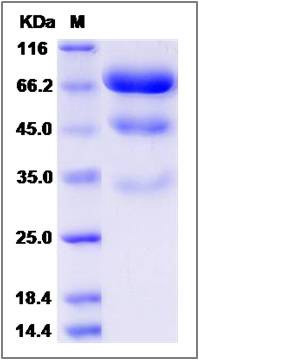Human PLBD2 Protein (His Tag)
P76
- 100ug (NPP2413) Please inquiry
| Catalog Number | P13947-H08H |
|---|---|
| Organism Species | Human |
| Host | Human Cells |
| Synonyms | P76 |
| Molecular Weight | The recombinant human PLBD2 consists of 559 amino acids and predicts a molecular mass of 62.7 KDa. It migrates as an approximately 68,46 and 34 KDa band in SDS-PAGE under reducing conditions. |
| predicted N | Ile 42 |
| SDS-PAGE |  |
| Purity | (69.5+23.3+6.5) % as determined by SDS-PAGE |
| Protein Construction | A DNA sequence encoding the human PLBD2 (Q8NHP8) (Met1-Asp589) was expressed with a polyhistidine tag at the C-terminus. |
| Bio-activity | |
| Research Area | Immunology |Signal Transduction |Metabolism |Lipid metabolism |
| Formulation | Lyophilized from sterile PBS, pH 7.4. 1. Normally 5 % - 8 % trehalose and mannitol are added as protectants before lyophilization. Specific concentrations are included in the hardcopy of COA. |
| Background | PLBD2 localizes to the lysosome, as its absence could plausibly lead to a serious yet unrecognized lysosomal storage disease. PLBD1 and PLBD2 are semi-orphans in the sense of being probable phospholipases of B class but with uncertain physiological substrates and thus functionalities. PLBD1 and PLBD2 constitute a small gene family (sequence homology class) within vertebrates though one that occurs expanded in some early diverging eukaryotes. PLBD2 presents a special difficulty in that a sequence of post-translational steps are apparently necessary for its activation. Without these, potential substrates can hardly be assayed. These steps include removal of the signal peptide, mannosylation appropriate to the lysosome targeting receptor, and self-catalytic proteolytic activation to expose the substrate binding site as this becomes appropriate. |
| Reference |
